All western saddles extend over the loin
Posted by RodandDenise on August 7, 2012
We are no longer building saddle trees, but we have two videos about how Western saddles fit horses available on our westernsaddlefit.com website.
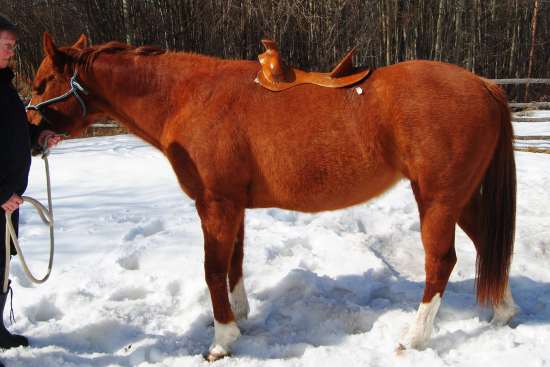
Now that we have finished the last foreleg muscles I'm going to talk about, but before we get to that hind limb muscle that can be affected by poor saddle fit, I feel I again need to make a point I have stated before. (It has obviously been a while since I planned this post. No, we don't have snow in August!) To those who have only ridden Western or who don't read about "saddle fit rules" on the internet, this is a no-brainer. But for those who live in Europe, or who primarily ride English, or who do read the lists of "saddle fit rules" all over the internet, this may sound like heresy.
In fact, after the last post about whether the loin of a horse can tolerate weight or not, we had an e-mail from a saddle maker in Spain. He told us that his vet scolded him for using trees that went past T18. A Swedish saddle maker also told us that he cannot join the Swedish Saddle Maker's Association because he won't sign their statement which contains an agreement to never build a saddle that goes past the 18th rib. When it comes to Western saddles, is this even possible?
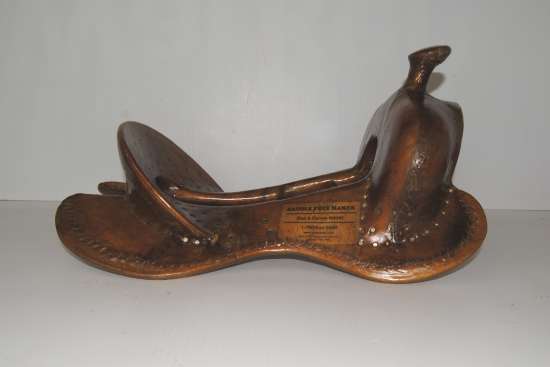
Here is one of our itty-bitty kiddie trees. (It is an 11" wide Modified Association with an 11" seat length, 6 1/4" thigh length.) The bars on this tree measure only 19" long because this tree was built for a grandchild of a saddle maker who was barely walking yet. He wants it to last his grandkids till they are between 7 and 10 years old. So a very small child's saddle tree.
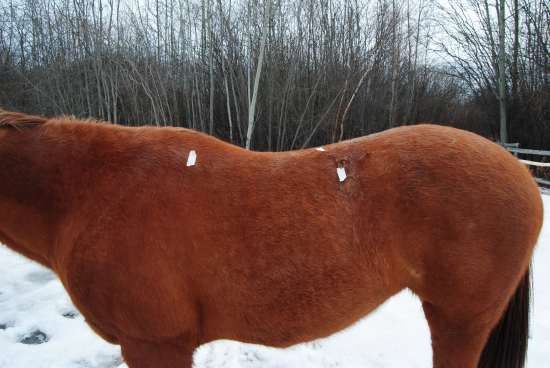
Here is Dancer. She is a 16 hand Quarter Horse with a fairly long shoulder to hip measurement of 28". The distance between the shoulder and last rib (as marked by the lower two pieces of tape on her back) is 18". The top piece of tape marks the approximate spot of T18. Behind that is officially "loin".
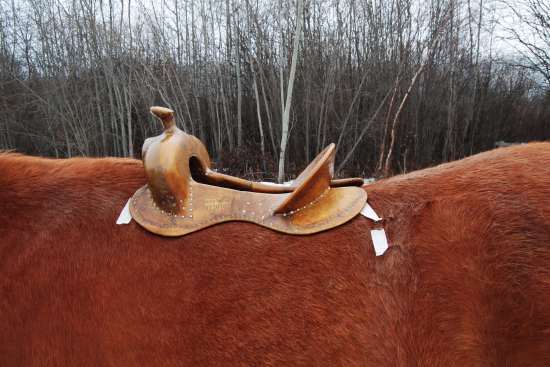
Here is the small kids' tree on Dancer, positioned properly with the front bar tip behind the shoulder blade.
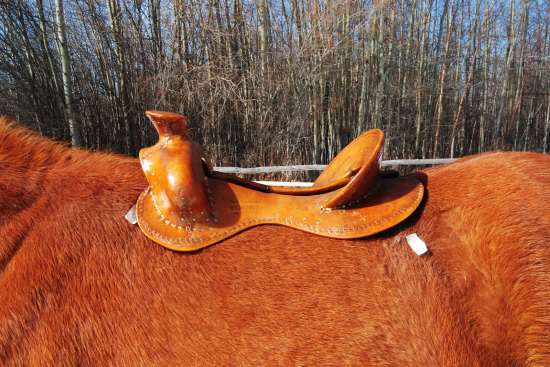
Here is one of ours with 23 1/4" bars, again positioned with the front bar tip behind the shoulder blade, which is where it should be placed. (This one is a 13" wide wood post Packer.)
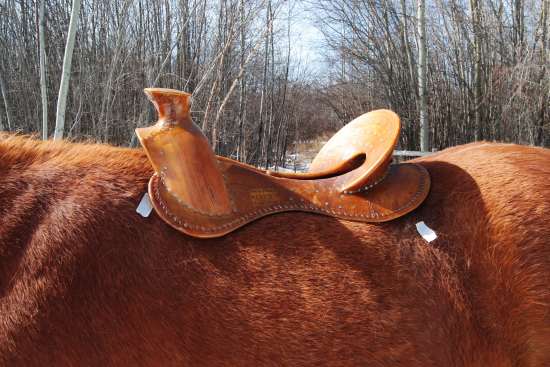
And here is one of our Wades with 23 7/8" bars, once again positioned with the front bar tip right behind the shoulder blade, which is the proper position for a western saddle tree.
In the post comparing bar surface area, the Ralide tree we measured had 22" bars and the old Bowden tree bars measured 23". They ALL extend onto the loin of the horse, even the 11" seat length kid's tree!!
If it is really true that a horse cannot tolerate weight on his loin without damaging him then NO western saddle trees can ever fit horses. So how have horses survived being ridden in Western trees for all these years?
It's a myth!
The answer - the popular internet saddle fit "rule" is simply a myth. It comes as unsubstantiated opinion from the mouths of people who are used to English saddles. (Excess pressure is another thing, and is as damaging on the loin as anywhere else on the horse's back.) The fact that it is imposed as a "rule" on Western saddles shows that the people making these claims really don't understand Western saddles, how they are built or how they work at all. And really, they don't understand their anatomy or their equine history that well either.
Here is a page with a very brief history of saddles showing ancient riders sitting on the hip and loin of horses. (And to show that this isn't just made up and drawn, here's a picture of someone riding on a donkey's hip from relatively recently.)
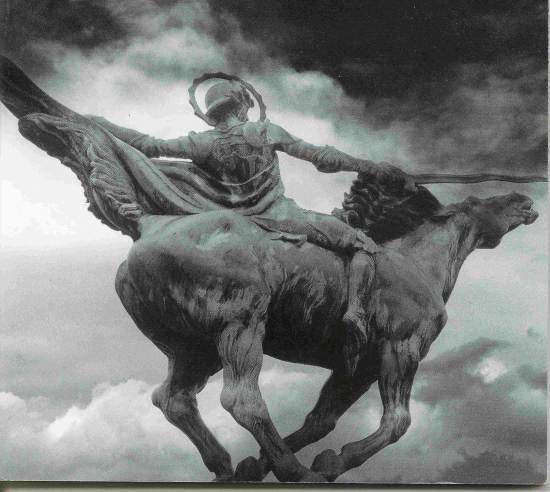
And here is a picture of a statue with an ancient rider sitting on the loin of his horse. (I'm sorry that I have no more information on where this statue is or who/what time period it is supposed to depict.)
It is a good thing all these ancient warriors didn't know they were breaking "the rule". On the other hand, thinking about how courageous and skilled they must have been to enter hand to hand combat riding bareback, I really don't think they would have cared all that much about "the rule". They, like the working cowboys and other western riders of today, knew better.
Next, back to that hind end muscle...
Comments:
Posted by Galadriel on Aug 10th, 2012
Have you used your delightful new pressure sensor, yet, to see if the back of the bars are really putting noticeable amounts of weight on the loin? From what I've observed in horses whose backs felt *great*, so their Western saddle really seemed to be fitting well, as they're moving the pressure under each region of the saddle changes (of course). But it appears that the loin is never carrying as much weight as the bar in front of the cantle, at any part of the horse's stride. (I'm not going to make any kind of pronouncements about weight shifts during various performance moves, though; sliding stops certainly, leaning back to counterbalance various positions and movements, weight shifts on the saddle during roping, I'm sure you know what I mean. Those are going to be momentary, though, not heavy, consistent, hours-long weight-bearing.)
Your typical English saddle has so much less surface area that the pressure under any particular region is greater. Since the loin *is* a little more delicate than the thoracic spine, I don't want that kind of pressure directly on the loin. And if the back of the saddle does end up there, it usually means there's a problem: the tree is a bad fit overall, the rider/horse mismatch is bad enough that the rider is positioned poorly on the back, etc. Sometimes the horse just has an absurdly short back and putting a normally sized, normally adjusted saddle on it will cause enormous fit problems. An English saddle sitting on the loin usually means "things are WRONG."
Now, I want that smaller surface area for a lot of the things I've done in an English saddle; jumping repeatedly, for example, I wouldn't want anything projecting onto the loin so the horse's back can flex and extend just about as far as it will go, over and over. A jumping saddle even usually has a tree & panels that curve way up at the cantle, to accommodate that kind of motion and try not to dig into the loin as the loin comes up to meet it. So certainly, you don't want a jumping saddle's weight-bearing surface to extend beyond the last rib, because it can critically interfere with the loin as it moves.
But you may see that some newer saddles--for example, dressage saddles meant only for flatwork--are getting longer and longer; a lot of the time their panels do extend somewhat onto the loin, and that's okay. I note the same thing about them that I do about a Western bar: the weight is primarily at or in front of the cantle, and the back of the panel serves to help spread out pressure at the back edges (good flare), and help spread the weight over a larger surface area overall. Making the panels longer sometimes allows them to be wider, too, and you know how much that helps. This is excellent, and as long as it's suitable for the horse and the work he does, there is no fitting problem with the saddle extending to the loin.
Posted by RodandDenise on Aug 10th, 2012
Galadriel,
Thank you for your comment. It points out one of the huge differences between English and Western saddles. When an English saddle has pressure on the loin, it pretty much means the rider is sitting well back on the horse. There isn't a lot of saddle behind the rider on an English saddle. When the back of the bars of a Western saddle have pressure on the loin, the rider is well ahead of that spot (unless the cantle is positioned too close to the back of the bars in a badly designed saddle). On our bars, we have 6" of bar behind the cantle cut at the front of the cantle. Then the saddle maker has put his whole groundseat in on the front of the cantle, and the low spot - where the pin bones (seat bones in the English world!) rest is usually ahead of the front corners of the cantle. So we are talking 7 - 8" at least from the back of the bar to where the concentration of the rider's weight is pressing down on the saddle. The idea of standing on a short board on soft ground comes in here. If you stand in the center of the board, it sinks in evenly and supports your weight. If you stand on one end, that end digs in and the other end lifts off. The longer bars on a Western saddle "extend the length of the board", if you will, to help keep the rider's weight from causing that back end to dig in. There isn't much 'board" behind an English rider. English and western saddles are designed very differently, and it is when "the rules" are extrapolated from one to another without the "rule" makers understanding this difference that we get these misconceptions about Western saddles.
We haven't had a lot of chance to use the pad yet, but in the couple we tested where there was not much pressure on the loin, the pressure on the front of the tree was much higher, to the point of concern. If there is no pressure on the back of the bar on a Western saddle when it bears weight (not when it is cinched and not being ridden), it is probably tipping forward, showing that it is either too wide, has too much angle, has too much rock for that horse, etc., and that causes problems. I also want to point out that if the pressure is distributed evenly over the whole bar surface (the ideal) then the percentage of pressure and total amount of pressure on the loin is fairly small since the percentage of the bar over the loin is fairly small.
As you point out, there is also a major difference between distributing pressure (carrying it's even share of the well distributed weight) and digging in. Since the back bar tip rounds into a fairly narrow end, if it digs in, it can put high amount of point pressure on a horse and that is very detrimental to a horse. We have always gone on the side of too much rock rather than too little just to avoid that high pressure on the ends of the bars. That is a "no go" situation for sure.
Posted by Moreach on Jan 16th, 2016
This all interests me in that one rides a donkey/ass/burro on the loin/rump and not the shoulder, yet of course it's an equine and close enough it can breed with a horse.
(I think the statue is St. George, due to the "attributes" of the saints. No idea where... but sculptors have as much "artistic license" as any artist and I wouldn't use it to prove anything.)
Posted by RodandDenise on Jan 16th, 2016
Moreach,
I totally agree that artists draw what they think they see (if they are trying for reality), which can be affected by preconceived ideas, or what they want to see (if they are trying to make a point or make good art they way they see works), which is why drawings and paintings are always suspect in where they place riders and how they draw horses and gear. However, there has to be some basis in fact for the many historic artifacts that show riders in different places on the equine (we'll go generic there... :) ) The link in the main body to the history of the saddles demonstrates both of the above points - artistic license (real horses don't look like most of those illustrations) and the wide variation in where people have sat on horses over time and in various places in the world. To my knowledge there are no studies that have been done trying to figure out where the best place is for the rider on the horse. I think it would be a very difficult study to do. But there is a lot stated as fact that is really still just opinion. Ultimately, how well your horse moves and works tells the tale...







